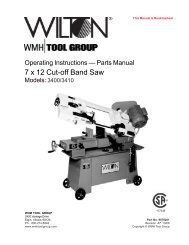Continental L-Head Overhaul Manual - Igor Chudov
Continental L-Head Overhaul Manual - Igor Chudov
Continental L-Head Overhaul Manual - Igor Chudov
Create successful ePaper yourself
Turn your PDF publications into a flip-book with our unique Google optimized e-Paper software.
1. DI~,CONNECT THE BATTERY, before<br />
connecting or disconnecting test instruments<br />
(except voltmeter) or before remo~Ting<br />
or replacing any unit or wiring.<br />
Accidental grounding or shorting at the<br />
reg:alator, alternator, ammeter or accessories,<br />
will cause severe damage to the<br />
unil:s an.d/or wiring.<br />
2. TO AVOID DAMAGE TO THE REGU-<br />
LATOR, DO NOT, AT ANY TIME,<br />
CONNECT BATTERY TO THE REG-<br />
ULATOR FIELD TERMINAL.<br />
3. THE FIELD CIRCUIT MUST NEVER<br />
BE GROUNDED, ON THIS SYSTEM,<br />
BETWEEN THE ALTERNATOR AND<br />
THE REGULATOR. Grounding of the<br />
field terminal either at the alternator or<br />
regulator will damage the regulator.<br />
4. IF IT IS NECESSARY TO SOLDER<br />
ANY LEAD TO A RECTIFIER LEAD,<br />
use a pair of pliers as a heat dam between<br />
the solder joint and the rectifier.<br />
5. THE ALTERNATOR MUST NOT BE<br />
OPERATED ON OPEN CIRCUIT WITH<br />
THE ROTOR WINDING ENERGIZED.<br />
6. DO NOT ATTEMPT TO POLARIZE<br />
THE ALTERNATOR. No polarization<br />
is required. Any attempt to do so may<br />
resc~lt in damage to the alternator, reglator,<br />
or circuits.<br />
7. GROUNDING OF THE ALTERNATOR<br />
OU~?PUT TERMINAL MAY DAMAGE<br />
THE ALTERNATOR AND/OR CIR-<br />
CUIT AND COMPONENTS.<br />
8. REVERSED BATTERY CONNEC-<br />
TIONS MAY DAMAGE THE RECTIFI-<br />
ERS, WIRING OR OTHER COMPON-<br />
ENTS OF THE CHARGING SYSTEM.<br />
Battery polarity should be checked with<br />
a voltmeter before connecting the battery.<br />
9. IF A BOOSTER BATTERY OR FAST<br />
CHARGER IS USED, ITS POLARITY<br />
MUST BE CONNECTED CORRECTLY<br />
TO PREVENT DAMAGE TO THE<br />
ELECTRICAL SYSTEM COMPON-<br />
ENTS. (POSITIVE TO POSITIVE,<br />
NEGATIVE TO NEGATIVE).<br />
IV. Regulator<br />
Pa~e 51D<br />
Some regulators are fully transistorized<br />
and completely .sealed. These can not be adjusted<br />
or repaired, and it can be assumed<br />
that this type regulator will outlive the other<br />
components in the charging system.<br />
Other regulators are adjusted and repaired<br />
in accordance with the manufacturer’s instructions.<br />
Installation of Regulator for Alternator<br />
To insure proper operation and to protect<br />
the alternator and regulator, the following<br />
steps should be observed during installation.<br />
1. Make sure regulator is of the same voltage<br />
and polarity as the alternator and<br />
battery.<br />
2. Disconnect battery cable at battery terminal.<br />
Make sure the mounting area of the alternator<br />
and regulator base are clean<br />
and make a good tight connection.<br />
Connect alternator in accordance with<br />
the manufacturer’s instructions.<br />
5. Do not flash field or ground terminals<br />
of the regulator.<br />
Reconnect battery cable.<br />
Start engine and observe ammeter. A<br />
"High" charge rate is normal for the<br />
first few minutes, but will decrease as<br />
the regulator warms up.<br />
NOTE<br />
: When servicing the charging system, never<br />
remove a unit until tests have shown<br />
it to be defective. Reference always<br />
should be made to the manufacturer’s<br />
maintenance manuals for a complete<br />
trouble shooting story.
















